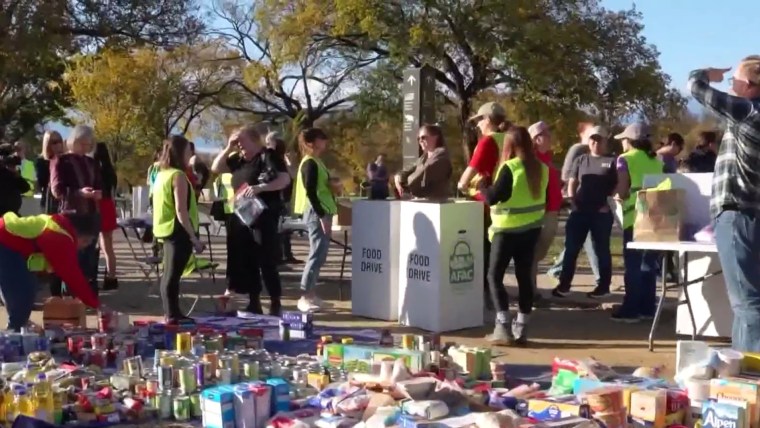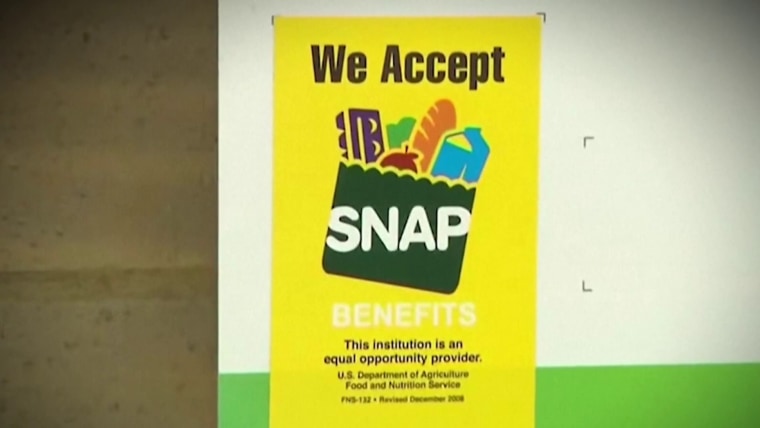The Trump administration said in court filings Monday that it would use contingency funds to provide partial SNAP benefits in November after a judge on Friday ordered the Department of Agriculture to disburse funding for the program.
The administration said that it would use all $4.65 billion in contingency funds, which will cover about half of each eligible household's benefits this month.

The administration said it would need at least $4 billion in additional government funds to provide full SNAP benefits, also known as food stamps.
Agriculture Secretary Brooke Rollins, in a social media post Monday night, said, "It will take several weeks to execute partial payments." She added that when the government reopens, “FULL benefits can get to families without delay.”
While the administration said it considered using funds from the Agriculture Department's Section 32 funds, the White House ultimately decided that those funds “must remain available to protect full operation of Child Nutrition Programs throughout the fiscal year, instead of being used for SNAP benefits.”
“Section 32 Child Nutrition Program funds are not a contingency fund for SNAP,” said the filing, which was signed by Agriculture Department Under Secretary Patrick Penn.
“Using billions of dollars from Child Nutrition for SNAP would leave an unprecedented gap in Child Nutrition funding that Congress has never had to fill with annual appropriations, and USDA cannot predict what Congress will do under these circumstances,” it said.
The filing noted that because the administration was using the contingency funds, there would be no remaining funds for new SNAP applicants, “disaster assistance, or as a cushion against the potential catastrophic consequences of shutting down SNAP entirely.”
Democracy Forward, the group representing the plaintiffs, said it was "considering all legal options" to try and facilitate the full payments.
"It shouldn’t take a court order to force our President to provide essential nutrition that Congress has made clear needs to be provided," Democracy Forward President and CEO Skye Perryman said. "But since that is what it takes, we will continue to use the courts to protect the rights of people."
We’d like to hear from you about how you’re experiencing the government shutdown, whether you’re a federal employee who can’t work right now, a person who relies on federal benefits like SNAP, or someone who is feeling the effects of other shuttered services in your everyday life. Please contact us at [email protected] or reach out to us here.
On Friday, U.S. District Judge John McConnell of Rhode Island ordered the Trump administration to make a full SNAP payment by the end of the day Monday or a partial payment by Wednesday. In order to make the full SNAP payment, the administration would have to draw on additional funding sources beyond the contingency reserves.
“There is no question that the congressionally approved contingency funds must be used now because of the shutdown; in fact, the President during his first term issued guidance indicating that these contingency funds are available if SNAP funds lapse due to a government shutdown,” McConnell wrote in his order, pointing to a 2019 Q&A email written by a SNAP administrator.
He ordered the administration to report by noon on Monday “what it will do to comply with this Court’s Order.”
McConnell’s ruling came after another federal judge said in a separate case that those suing the administration were “likely to succeed on their claim that Defendants’ suspension of SNAP benefits is unlawful.”
U.S. District Judge Indira Talwani of Massachusetts said last week that she will “allow Defendants to consider whether they will authorize at least reduced SNAP benefits for November, and report back to the court no later than Monday, November 3, 2025.”
More than 40 million people across the country use SNAP benefits to buy food, raising concerns about how low-income people will put food on the table if the program grinds to a halt. Tens of millions of Americans did not receive their November SNAP benefits this weekend due to the shutdown, which is just days away from becoming the longest in U.S. history.
Across the country, the shutdown’s impact was visible in long lines at food banks. This weekend in Texas and California, stadium parking lots were converted into mass distribution sites where families picked up boxes of produce, frozen meat and other household staples.
In the days before the November SNAP funding was expected to run dry, many state governments tried to help fill the gap. Last week, Democratic leaders from 25 states also sued the Agriculture Department, trying to force the department to use contingency funds to keep the program operating as the shutdown continues.
The department had previously argued that contingency funds were “not legally available to cover regular benefits,” but were instead supposed to be reserved for situations like natural disasters.
In her social media post, the agriculture secretary also said that full November benefits for the WIC program — which provides free, healthy food to low-income pregnant women, new moms and children under 5 — were being disbursed to states on Monday.


